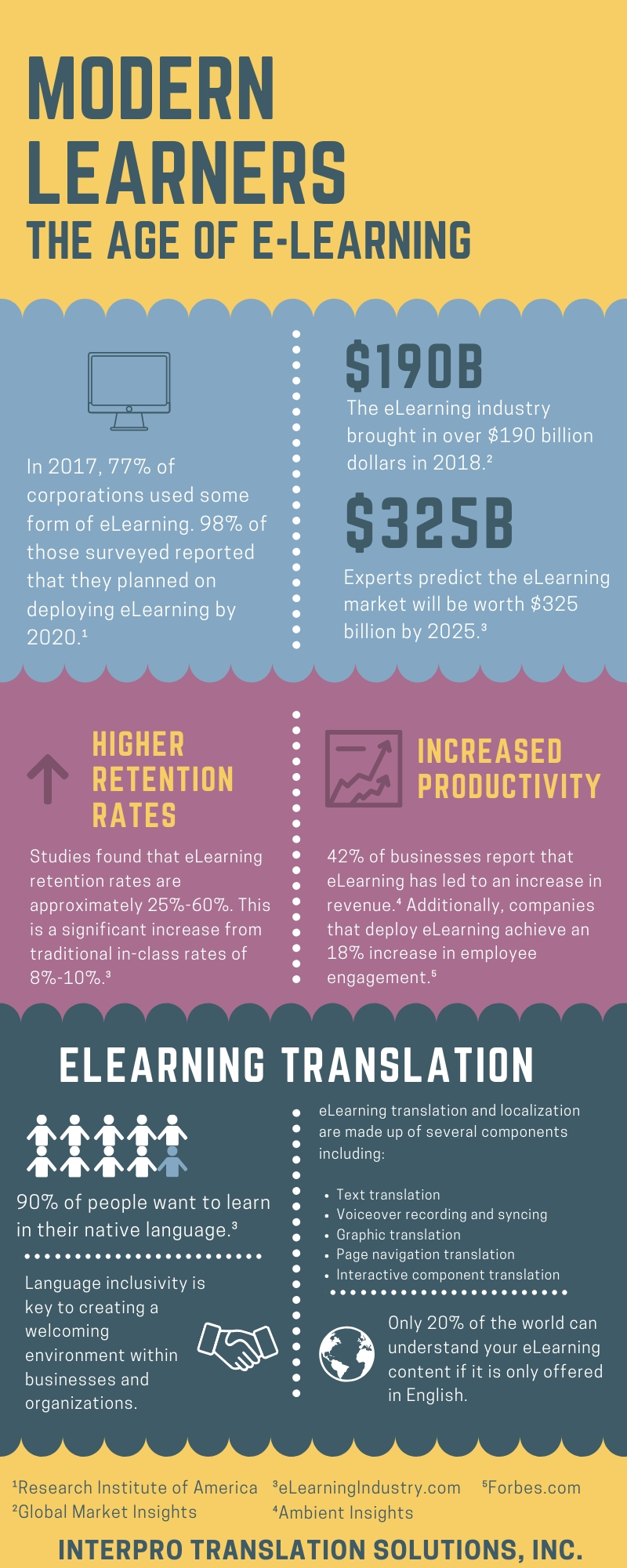In this article learn what eLearning is, and how eLearning translation can help your training materials resonate better with your audience.
Today’s digital age has done more than change the way we communicate, socialize, and conduct business. It has also had a significant impact on the way that we learn. Online learning, often called “eLearning”, is becoming a popular alternative to traditional in-class instruction due to its accessibility, effectiveness, and scalability.
As effective as eLearning is, presenting material in one language (like English) is a mistake. You may fail to reach a significant percentage of your audience. This is why eLearning translation is a vital component of a successful online course.

What is eLearning?
As the name implies, eLearning is a form of teaching that utilizes online technologies to instruct people outside of a classroom setting. It can include videos, training documents, or the website where the course lives.
Think of it as an online classroom for schools and places of higher education. However, eLearning actually is utilized across many industries: education, manufacturing, associations, nonprofit organizations, the medical field, and more. Online courses make it easy to educate others, train a global workforce, and provide resources to people around the world.
Benefits of eLearning
There is a wealth of benefits associated with eLearning, both for students and for the organizations providing the courses. A few advantages include:
1. Accessibility
Coordinating in-class training times can be problematic for businesses. Accommodating everyone’s schedule is nearly impossible and cuts into valuable time for teams. The fix is eLearning courses that are available on-demand and can be taken at any time. People can conveniently learn at their own pace when it best fits into their schedule.
Thanks to the services of professional translation companies, eLearning translation is easy. By working with a professional agency, you can translate your course into any language. This means that not only can these courses be accessed anywhere in the world, but they can also reach anyone, regardless of the language spoken.
2. Increased Material Retention
According to the Research Institute of America, eLearning information retention rates range between 25% -60%. This is a significant increase from traditional classroom learning (only 8% – 10% retention rate). Part of this is because instead of an instructor setting the pace of the course, eLearners can learn at their preferred speed, and then review material if necessary.
3. Scalability & Cost Effectiveness
Digital-based learning courses typically require 40%-60% less employee time compared to traditional settings, making it a smart financial decision for businesses. eLearning is also scalable, meaning a company can easily provide a course to 10 people or 1,000 people.
Additionally, thanks to eLearning translation, language doesn’t have to be a barrier. Students learning in their native language will retain more of the information. This creates consistency in organizations and prevents variations that can occur between different instructors and in-person learning settings.
How are eLearning courses developed?
Courses can be delivered in a number of ways: video, narrated slideshows, quizzes, surveys, and games, just to name a few. There are several course authoring tools available on the market that allow instructors to create their own courses, including:
- Storyline 360
- Storyline 3
- Articulate Rise
- Adobe Captivate
- Internally-developed web-based tools
Additionally, editing software such as Vyond and Adobe Premiere can also be used to create video content, which can be included as part of your training.
After they are created, courses are typically published on a Learning Management System (LMS). This allows creators to streamline all courses in one convenient location.
eLearning’s Popularity
eLearning use has been on the rise for years, and experts say it shows no signs of slowing down. In fact, studies predict that by 2025, the online learning market will be worth $325 billion— a 300% increase from 2015 levels. In 2017, approximately 77% of corporations in the United States utilized some form of online learning, and 98% of those surveyed reported that they planned to deploy it by 2020.
In the midst of the COVID-19 pandemic, eLearning has become a necessity for many. The industry has been at the forefront as schools and companies come up with work-from-home solutions. Thanks to the quick ramping up and preparation of eLearning companies, so many have been able to take advantage of what online learning has to offer during this time of crisis.
Why is eLearning translation important?
eLearning translation can increase your audience reach and help the learner retain more of the information from the course.
eLearning is only effective if the audience can understand what is being said. If you are a company or organization with a multilingual audience, eLearning translation is a must. The course content needs to be delivered in the language that your audience best understands. An accurate and culturally appropriate translation is the key to facilitating understanding and retention of the material.
When people are presented with content in their native language, it creates an inclusive and welcoming environment. Statistics show that 90% of people prefer learning in their native language. By giving your learners a course that they can understand, you show that you care. When creating your course, it’s important to follow some best practices that make eLearning translation straightforward.

How does eLearning translation work?
The process for eLearning translation differs from course to course. For example, the workflow for a Storyline translation may differ from that of a course created with Adobe Premiere. But, generally speaking, your eLearning translation may involve a combination of the following:
Text Translation
All eLearning translation begins with translating the written text in a course. However, this goes beyond what might appear in course videos. Graphics, buttons, interactive components like quizzes and games, and additional resources should also be translated, correctly formatted, and seamlessly integrated into the course. Even the website or landing page the course lives on and any linked documents will need to be translated as well – think about items study guides, reference materials, and instruction documents.
Audio Recording and Syncing
Most all eLearning translation processes include translating video, either through voice-over narration, or subtitles. To effectively translate these, audio must be transcribed, translated, re-recorded (or written in the case of subtitles) in the target language, and then synced into the course. In each of these steps, accuracy is crucial for a good eLearning translation. Recording should be done in a professional studio setting by a native-speaking talent in order to ensure quality. After recording, the audio needs to be synced into the course in a way that makes sense to the user.
Localization
To have a learning course successfully translated, companies should opt for a translation service that not only translates but localizes course content for its target audience.
Localization does more than simply translate words. It ensures that cultural nuances are taken into account, visuals are appropriate, and all content is understood in context by your target audience.
After a course is translated, it should undergo comprehensive Quality Assurance by a native speaker of the target language in order to ensure the entire course and all of its components are fully and correctly translated.
Conclusion
Because of its adaptability, effectiveness, and scalability, eLearning has quickly become the most widespread way to educate and train your workforce, students, and organization members. If operating within a multilingual organization, eLearning translation is key to ensuring that all participants can effectively learn and understand the material. Teaming up with a professional translation company capable of handling all aspects of eLearning translation and localization will ensure success for your organization, no matter the course topic or language.


